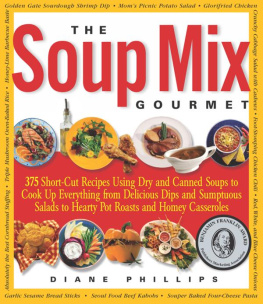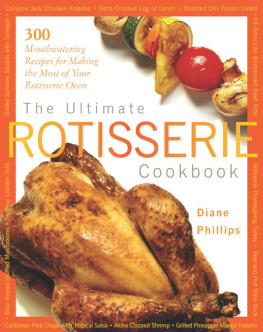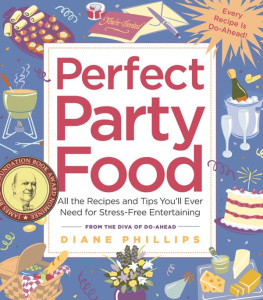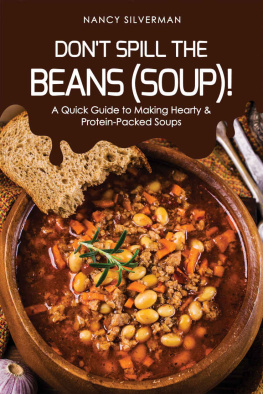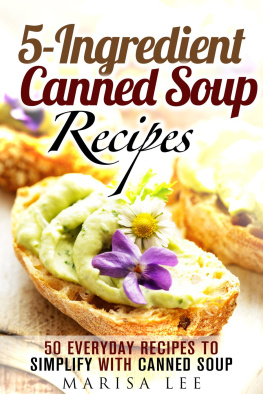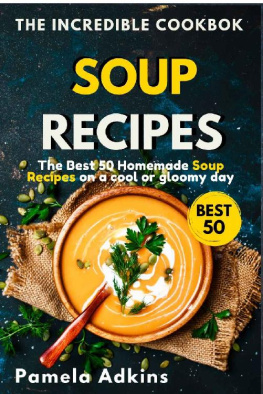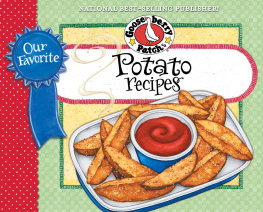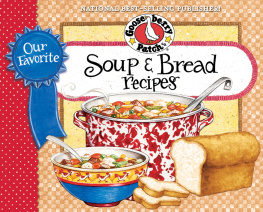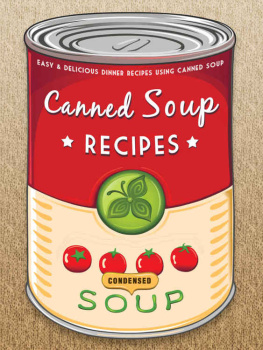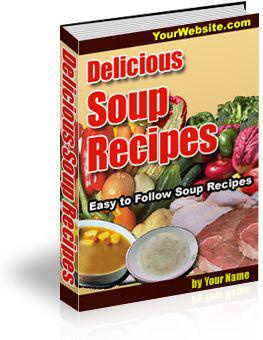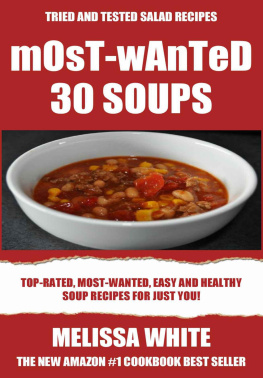The Harvard Common Press
535 Albany Street
Boston, Massachusetts 02118
2001 by Diane Phillips
Illustrations 2001 by Melanie Marder Parks
Campbell's is a registered trademark of the Campbell Soup Company. The following recipes are used with permission: Tomato Soup Cake, Quick Tomato Spice Cake, Rosy Rocks, The Original Campbell's Chicken Tetrazzini, Glori-Fried Chicken, Campbell's Original Beef Stroganoff, and The Original Campbell's Shrimp Creole.
Lipton Recipe Secrets is registered trademark of Unilever. The following recipes are used with permission: Original California Dip, Onion Burgers, and Lipton's Old-Fashioned Meat Loaf.
Knorr is a registered trademark and Recipe Classics is a trademark of Knorr-Naehrmittel AG.
Any product name that is capitalized in this book is a registered trademark.
All rights reserved. No part of this publication may be reproduced or transmitted in any form or by any means, electronic or mechanical, including photocopying, recording, or any information storage or retrieval system, without permission in writing from the publisher.
Printed in the United States of America
Printed on acid-free paper
L IBRARY OF C ONGRESS C ATALOGING-IN- P UBLICATION D ATA
Phillips, Diane.
The soup mix gourmet : 375 short-cut recipes using dry and canned soups to cook up everything from delicious dips and sumptuous salads to hearty pot roasts and homey casseroles / Diane Phillips.
p. cm.
includes index.
ISBN 1-55832-208-6 (hc : alk. paper)ISBN 1-55832-209-4 (pbk. : alk. paper)
1. Cookery. 2. Brand name products. 3. Soups. 4. Quick and easy cookery. I. Title.
TX714.P476 2001
641.5dc21
2001014433
Special bulk-order discounts are available on this and other Harvard Common Press books. Companies and organizations may purchase books for premiums or resale, or may arrange a custom edition, by contacting the Marketing Director at the address above.
Cover design by Suzanne Heiser, Night & Day Design
Interior design by Richard Oriolo
10 9 8 7 6 5 4 3 2 1
To Bruce and Nonnie,
Fair winds and following seas,
May God bless you on this journey together
Acknowledgments
WRITING A COOKBOOK IS MUCH LIKE making a pot of soup. The author is assisted by individuals who contribute their individual talents to help build the flavor, and intensify the ingredients, until the book is published. During the writing of this book, I was blessed to work with so many talented people and to be supported by dear friends and colleagues. I would be remiss if I did not recognize and thank them publicly.
To my agent, Susan Ginsburg, the woman who makes my career sizzle, a ladle full of gratitude not only for her friendship, but also for being the best agent in the world. To her assistant, Annie Leuenberger, a sprinkle of thanks for all of her help keeping things straight during the marathon.
To my new family at The Harvard Common Press: Bowls of praise and gratitude to my editor, Pam Hoenig, who ate more chocolate than was necessary to keep the pages flowing, and for taking my words and recipes and making them bubble. To President Bruce Shaw, a serving of thanks for his generous support and commitment to this project, and for going the extra mile to get us to publication on time. To Valerie Cimino, Christine Alaimo, Skye Stewart, Sunshine Erickson, Abbey Phalen, Jodi Marchowsky, Georgina Duff, and Virginia Downes, spoons of appreciation for their help with managing the manuscript, marketing, design, and publicity. A special spoonful of thanks to Jed Lyons, Rich Freese, Spencer Gale, Keith Owens, James Penfield, and all the reps at NBN for their generous support and promotion of the book. Copy editor Maggie Carr deserves the silver spoon for taking my words and making them logical, organized, and, above all, coherent. Thanks to all who put so much time and effort into making this book a reality.
At home, I would like to make a toast to my husband, Chuck, who tasted, tested, and gave good advice with each trial and error. Above all, he is always there at the end of the day with a hug, and reassurance that it's okay to have five cases of soup in the dining room, and that we'll be having chicken for the tenth day in a row. Thanks, honey, I promise we won't eat any more soup for a while! To our children, Carrie and Ryan, a big hug for being there, and for cheering me on even when I forget to bake cookies and instead make another test recipe.
To my colleagues, cookbook authors extraordinaire Rick Rodgers and Lora Brody, bowls brimming with affection and respectyou are the most generous people I know and have been tremendous sources of inspiration and encouragement; thanks for that. A ladle of appreciation to Greg Smith at Lipton, Martha Reynolds at Knorr, Maureen Weiss at Unilever Corporate, and Lucinda Ayers at Campbell's for help with permissions and soup facts that have helped to sprinkle a little lightness into the text.
I would be inattentive if I did not thank my road families as well: the cooking schools and their students who welcome me into their kitchens and make my time on the road something special, giving me a home away from home. A stockpot filled to the brim with gratitude to the cooking school program managers, their staff, and students at: Draegger's, Sur La Table, Ramekins, Central Markets, Viking Culinary Centers, Kitchen Art, Cooks Wares, Kitchen Affairs, Dorothy Lane Markets, The Kitchen Shoppe, Loretta Paganini School of Cooking, Bama Cooking School, and Kitchen Conservatory.
Introduction
LOOK IN ANY PANTRY ACROSS the country and you will find dry and canned soups lining the shelves. With a glance into any group organization cookbook you will easily find that 75 percent of the recipes include soup as the main ingredient. Soup is a part of our culinary landscape, whether we know it or not. A lot of us may not know that our favorite meal growing up began with a can of soup.
Soups can be used to create any number of tasty dishes just by doctoring them up with a few additional ingredients. From appetizers to side dishes, soup (of course!) to main courses, soups can be gold in your pantry with just a little help from the The Soup Mix Gourmet.
Like many people today, my time is precious. If I can make my family a comforting, home-cooked meal by using something that will save time, I am all for it. Soups and soup mixes are a vital part of my pantry, and I've learned their strengths and limitations. Some soups just don't make the grade, while others help make my son's favorite chicken pot pie and my husband's favorite beef pot roast. Throughout this book you will find old favorites and new ideas for using soups to help you create memorable meals for your family. The best part is you don't have to stand over the stove for hours, there aren't a lot of labor-intensive steps or hard-to-find ingredients, and most of these dishes can be made ahead of time and either refrigerated or frozen.
I teach students all over the country, and my most popular classes are those we term "marathons," where I prepare eight to ten dishes in two and a half hours. Many of the recipes I teach in these classes use time-savers such as canned or dry soups to prepare dinners that you would be proud to serve to your family or the boss. These tricks also free home cooks from the bondage of thinking they have to make everything from scratch. Not all restaurants make their own stocks; they use a commercial soup base that comes in gallon drums. So why not take a cue from those chefs, and use the great resources available on the shelf in your supermarket to make some really good food?
Dry soups come in a variety of flavors and brands. Lipton and Knorr are the leading brands, and each makes a line of soup mixes that can be made into a soup or, by adding other ingredients to the mix, can serve as the basis for dips, salads, and dressings, main courses, sauces, and pastas. Another type of dry soup mix is ramen, a combination of dry noodles and a soup base that comes in a variety of flavors.
Next page
